Social Work Group Proposal: Supporting Teenagers with Disabilities
VerifiedAdded on 2023/06/12
|11
|3291
|250
Report
AI Summary
This proposal, addressed to the Senior Manager of the Australian Association of Social Workers (AASW), outlines the need for a support group for teenagers, particularly those with disabilities, to combat social isolation and promote social skills. The proposal details the group's purpose, goals, and expected outcomes, emphasizing empowerment, mutual support, and social connectedness. It also addresses practical considerations such as participant numbers, session duration, staffing requirements, and budget. The group aims to provide a safe space for sharing knowledge, fostering social inclusion, and advocating for human rights, utilizing strategies like Children Friendship Training (CFT) and Theory of Mind intervention (TOM). The document includes a budget breakdown covering salary expenses, advertising, catering, equipment, and other operational costs, and emphasizes the importance of evaluation through questionnaires and feedback to measure the group's effectiveness.

Running Head: Social Work With Groups
social work with groups
social work with groups
Paraphrase This Document
Need a fresh take? Get an instant paraphrase of this document with our AI Paraphraser
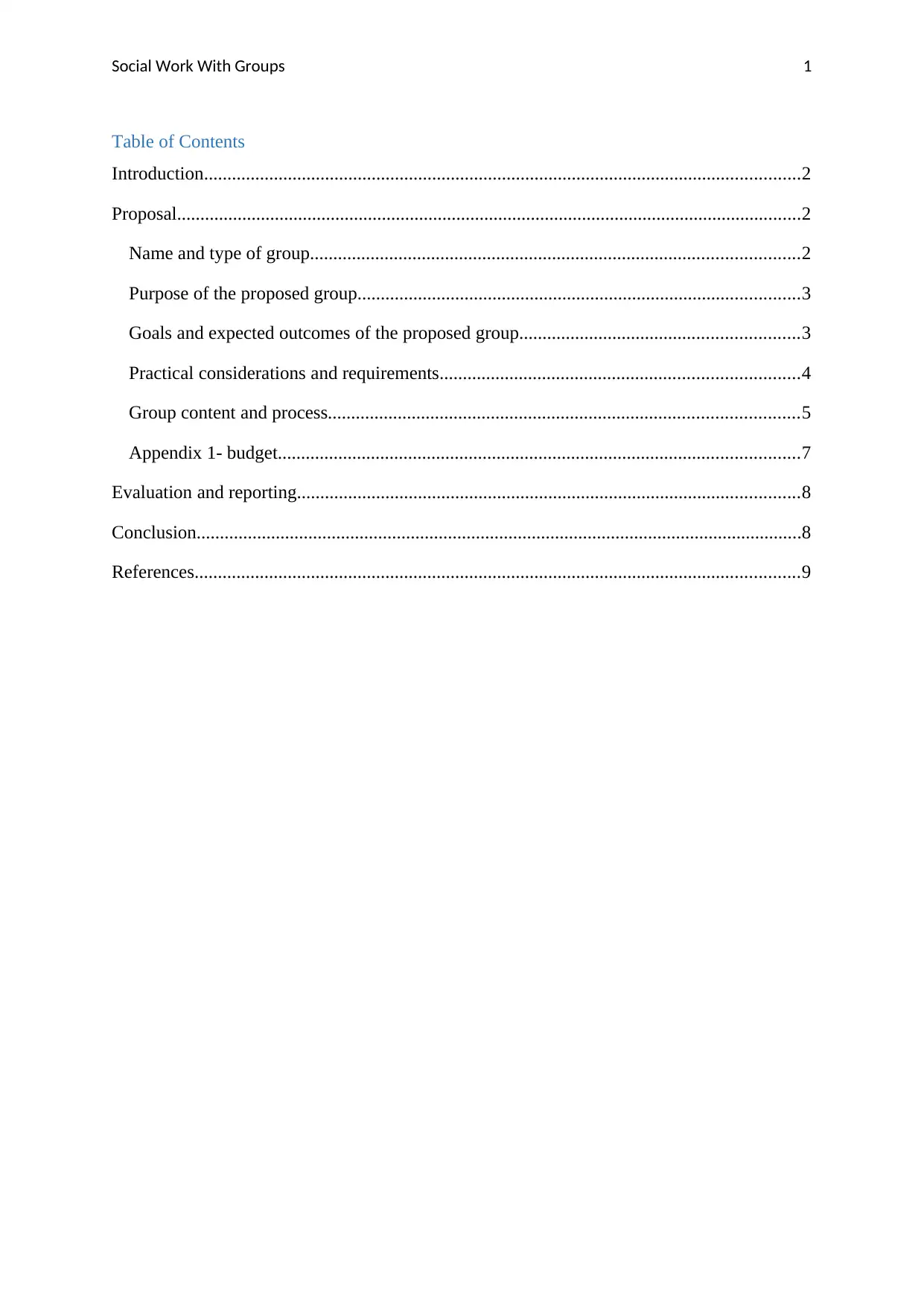
Social Work With Groups 1
Table of Contents
Introduction................................................................................................................................2
Proposal......................................................................................................................................2
Name and type of group.........................................................................................................2
Purpose of the proposed group...............................................................................................3
Goals and expected outcomes of the proposed group............................................................3
Practical considerations and requirements.............................................................................4
Group content and process.....................................................................................................5
Appendix 1- budget................................................................................................................7
Evaluation and reporting............................................................................................................8
Conclusion..................................................................................................................................8
References..................................................................................................................................9
Table of Contents
Introduction................................................................................................................................2
Proposal......................................................................................................................................2
Name and type of group.........................................................................................................2
Purpose of the proposed group...............................................................................................3
Goals and expected outcomes of the proposed group............................................................3
Practical considerations and requirements.............................................................................4
Group content and process.....................................................................................................5
Appendix 1- budget................................................................................................................7
Evaluation and reporting............................................................................................................8
Conclusion..................................................................................................................................8
References..................................................................................................................................9
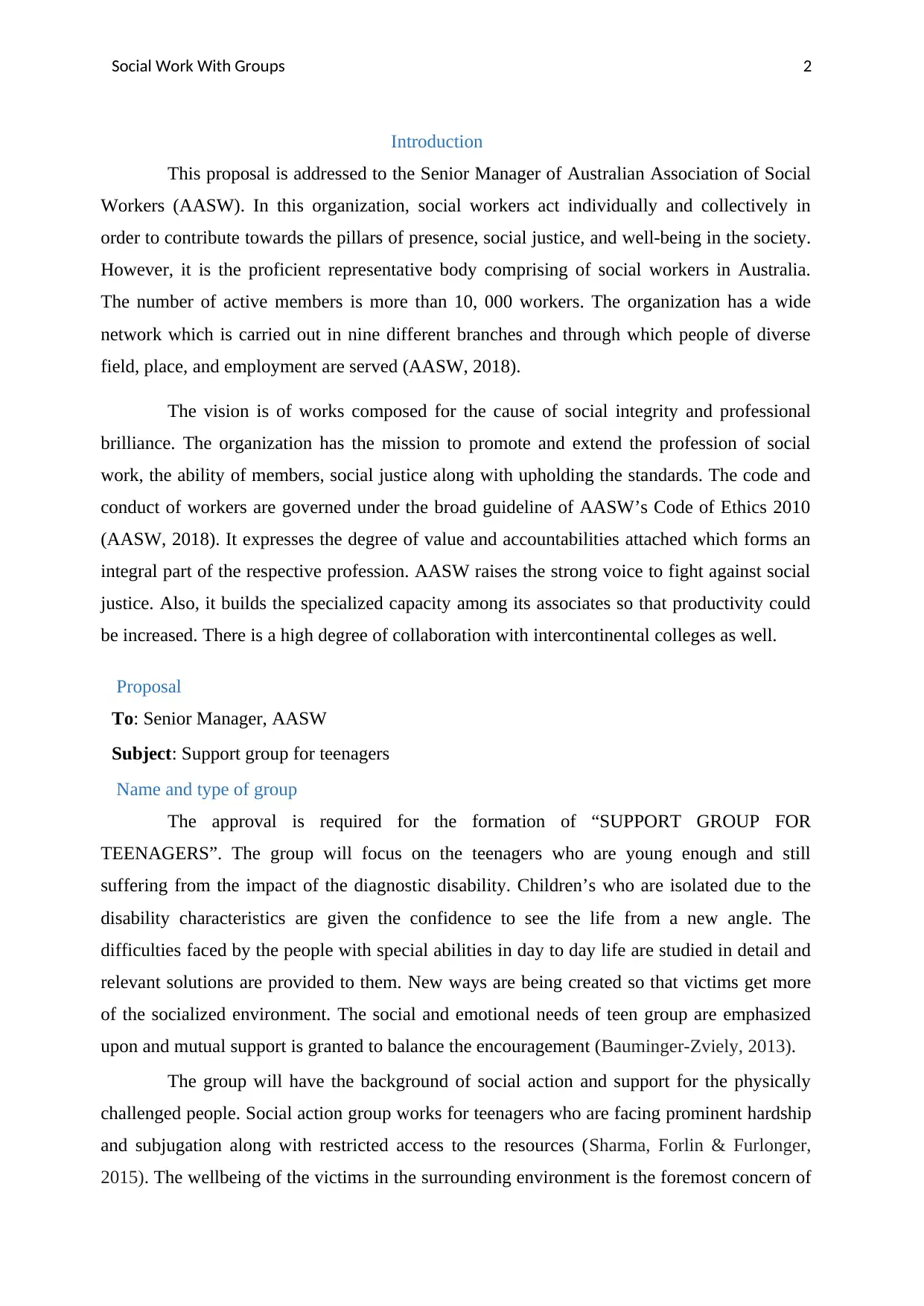
Social Work With Groups 2
Introduction
This proposal is addressed to the Senior Manager of Australian Association of Social
Workers (AASW). In this organization, social workers act individually and collectively in
order to contribute towards the pillars of presence, social justice, and well-being in the society.
However, it is the proficient representative body comprising of social workers in Australia.
The number of active members is more than 10, 000 workers. The organization has a wide
network which is carried out in nine different branches and through which people of diverse
field, place, and employment are served (AASW, 2018).
The vision is of works composed for the cause of social integrity and professional
brilliance. The organization has the mission to promote and extend the profession of social
work, the ability of members, social justice along with upholding the standards. The code and
conduct of workers are governed under the broad guideline of AASW’s Code of Ethics 2010
(AASW, 2018). It expresses the degree of value and accountabilities attached which forms an
integral part of the respective profession. AASW raises the strong voice to fight against social
justice. Also, it builds the specialized capacity among its associates so that productivity could
be increased. There is a high degree of collaboration with intercontinental colleges as well.
Proposal
To: Senior Manager, AASW
Subject: Support group for teenagers
Name and type of group
The approval is required for the formation of “SUPPORT GROUP FOR
TEENAGERS”. The group will focus on the teenagers who are young enough and still
suffering from the impact of the diagnostic disability. Children’s who are isolated due to the
disability characteristics are given the confidence to see the life from a new angle. The
difficulties faced by the people with special abilities in day to day life are studied in detail and
relevant solutions are provided to them. New ways are being created so that victims get more
of the socialized environment. The social and emotional needs of teen group are emphasized
upon and mutual support is granted to balance the encouragement (Bauminger-Zviely, 2013).
The group will have the background of social action and support for the physically
challenged people. Social action group works for teenagers who are facing prominent hardship
and subjugation along with restricted access to the resources (Sharma, Forlin & Furlonger,
2015). The wellbeing of the victims in the surrounding environment is the foremost concern of
Introduction
This proposal is addressed to the Senior Manager of Australian Association of Social
Workers (AASW). In this organization, social workers act individually and collectively in
order to contribute towards the pillars of presence, social justice, and well-being in the society.
However, it is the proficient representative body comprising of social workers in Australia.
The number of active members is more than 10, 000 workers. The organization has a wide
network which is carried out in nine different branches and through which people of diverse
field, place, and employment are served (AASW, 2018).
The vision is of works composed for the cause of social integrity and professional
brilliance. The organization has the mission to promote and extend the profession of social
work, the ability of members, social justice along with upholding the standards. The code and
conduct of workers are governed under the broad guideline of AASW’s Code of Ethics 2010
(AASW, 2018). It expresses the degree of value and accountabilities attached which forms an
integral part of the respective profession. AASW raises the strong voice to fight against social
justice. Also, it builds the specialized capacity among its associates so that productivity could
be increased. There is a high degree of collaboration with intercontinental colleges as well.
Proposal
To: Senior Manager, AASW
Subject: Support group for teenagers
Name and type of group
The approval is required for the formation of “SUPPORT GROUP FOR
TEENAGERS”. The group will focus on the teenagers who are young enough and still
suffering from the impact of the diagnostic disability. Children’s who are isolated due to the
disability characteristics are given the confidence to see the life from a new angle. The
difficulties faced by the people with special abilities in day to day life are studied in detail and
relevant solutions are provided to them. New ways are being created so that victims get more
of the socialized environment. The social and emotional needs of teen group are emphasized
upon and mutual support is granted to balance the encouragement (Bauminger-Zviely, 2013).
The group will have the background of social action and support for the physically
challenged people. Social action group works for teenagers who are facing prominent hardship
and subjugation along with restricted access to the resources (Sharma, Forlin & Furlonger,
2015). The wellbeing of the victims in the surrounding environment is the foremost concern of
⊘ This is a preview!⊘
Do you want full access?
Subscribe today to unlock all pages.

Trusted by 1+ million students worldwide

Social Work With Groups 3
the group. Sometimes, the student as a result of being different is treated in a negative way by
other colleagues at school. Apparently, the group will emphasize on practicing of social skills
and broadening of vision in the society in most effective manner.
Purpose of the proposed group
The purpose of the proposed group is to render a space to portion, disseminate and
increase the content of knowledge through the boundaries of Autism Sector. The group will
specifically focus work on following parameters:
1. Foyer towards the context of social work in the specialised sector.
2. It will provide the space for information sharing along with education (Thompson,
McFerran & Gold, 2014).
3. Moreover, an attempt is lined up to bring social workers altogether by highlighting the
importance of the issue.
4. There will be a certain amount of contribution to achieving strategic planning of
AASW as required.
The Support group for teenagers is needed to eradicate the evil and issues of social
exclusion from the society. The aforesaid issues create a vicious cycle which is so deliberate
in nature that it needs adequate support to overcome. Social isolation is the prominent
problem faced by the specialised people: therefore it requires a beleaguered and explicit
response. Subsequently, the group will be highly committed to promote and protect the basic
human rights (Wong, 2015). Group work provides the broad exposure on the grounds of
learning new skills, outlooks, and opinions. It defines the level of understanding through the
dimensions of explanation and discussion. Also, it develops tougher communication and
presentation skills. It saves time and cost to do a work. More complex problems are tackled
with an ease. Alongside, a delegation of various role and responsibilities makes every
member accountable and active (Steinberg, 2013).
Goals and expected outcomes of the proposed group
The beginning goals of the Support group for teenagers would be to empower the
people in building up of the personal capacity to fight back for such causes. To understand
and address the concern and circumstances faced by the teenagers. Identify the areas where
the occurrence arises on the major times and thereby, plan out the steps to prohibit the future
happening of causes. Additionally, it also focuses on fostering of adolescents participation,
mutual sustenance and social connectedness among the members of the group (Krcek, 2013).
the group. Sometimes, the student as a result of being different is treated in a negative way by
other colleagues at school. Apparently, the group will emphasize on practicing of social skills
and broadening of vision in the society in most effective manner.
Purpose of the proposed group
The purpose of the proposed group is to render a space to portion, disseminate and
increase the content of knowledge through the boundaries of Autism Sector. The group will
specifically focus work on following parameters:
1. Foyer towards the context of social work in the specialised sector.
2. It will provide the space for information sharing along with education (Thompson,
McFerran & Gold, 2014).
3. Moreover, an attempt is lined up to bring social workers altogether by highlighting the
importance of the issue.
4. There will be a certain amount of contribution to achieving strategic planning of
AASW as required.
The Support group for teenagers is needed to eradicate the evil and issues of social
exclusion from the society. The aforesaid issues create a vicious cycle which is so deliberate
in nature that it needs adequate support to overcome. Social isolation is the prominent
problem faced by the specialised people: therefore it requires a beleaguered and explicit
response. Subsequently, the group will be highly committed to promote and protect the basic
human rights (Wong, 2015). Group work provides the broad exposure on the grounds of
learning new skills, outlooks, and opinions. It defines the level of understanding through the
dimensions of explanation and discussion. Also, it develops tougher communication and
presentation skills. It saves time and cost to do a work. More complex problems are tackled
with an ease. Alongside, a delegation of various role and responsibilities makes every
member accountable and active (Steinberg, 2013).
Goals and expected outcomes of the proposed group
The beginning goals of the Support group for teenagers would be to empower the
people in building up of the personal capacity to fight back for such causes. To understand
and address the concern and circumstances faced by the teenagers. Identify the areas where
the occurrence arises on the major times and thereby, plan out the steps to prohibit the future
happening of causes. Additionally, it also focuses on fostering of adolescents participation,
mutual sustenance and social connectedness among the members of the group (Krcek, 2013).
Paraphrase This Document
Need a fresh take? Get an instant paraphrase of this document with our AI Paraphraser
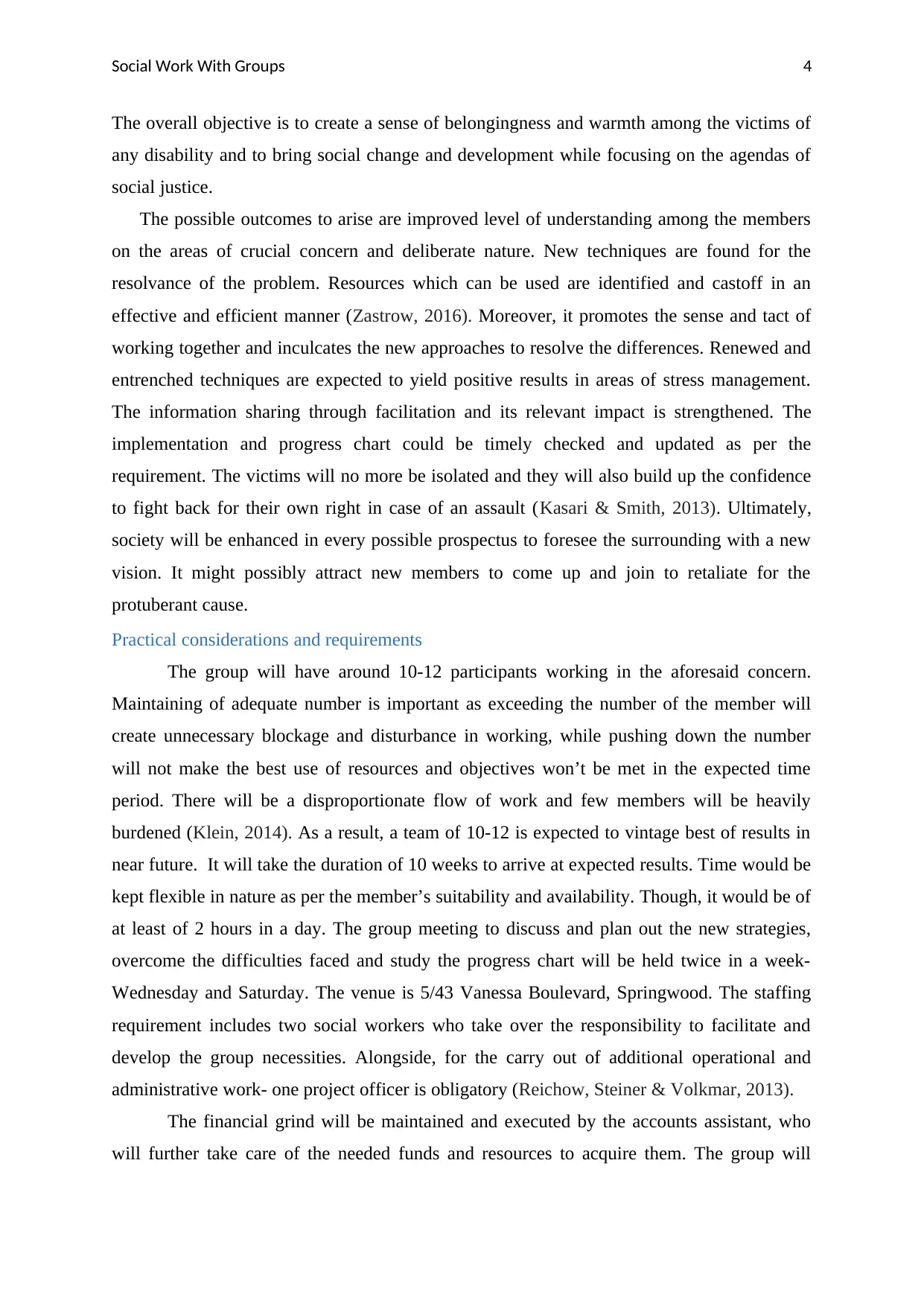
Social Work With Groups 4
The overall objective is to create a sense of belongingness and warmth among the victims of
any disability and to bring social change and development while focusing on the agendas of
social justice.
The possible outcomes to arise are improved level of understanding among the members
on the areas of crucial concern and deliberate nature. New techniques are found for the
resolvance of the problem. Resources which can be used are identified and castoff in an
effective and efficient manner (Zastrow, 2016). Moreover, it promotes the sense and tact of
working together and inculcates the new approaches to resolve the differences. Renewed and
entrenched techniques are expected to yield positive results in areas of stress management.
The information sharing through facilitation and its relevant impact is strengthened. The
implementation and progress chart could be timely checked and updated as per the
requirement. The victims will no more be isolated and they will also build up the confidence
to fight back for their own right in case of an assault (Kasari & Smith, 2013). Ultimately,
society will be enhanced in every possible prospectus to foresee the surrounding with a new
vision. It might possibly attract new members to come up and join to retaliate for the
protuberant cause.
Practical considerations and requirements
The group will have around 10-12 participants working in the aforesaid concern.
Maintaining of adequate number is important as exceeding the number of the member will
create unnecessary blockage and disturbance in working, while pushing down the number
will not make the best use of resources and objectives won’t be met in the expected time
period. There will be a disproportionate flow of work and few members will be heavily
burdened (Klein, 2014). As a result, a team of 10-12 is expected to vintage best of results in
near future. It will take the duration of 10 weeks to arrive at expected results. Time would be
kept flexible in nature as per the member’s suitability and availability. Though, it would be of
at least of 2 hours in a day. The group meeting to discuss and plan out the new strategies,
overcome the difficulties faced and study the progress chart will be held twice in a week-
Wednesday and Saturday. The venue is 5/43 Vanessa Boulevard, Springwood. The staffing
requirement includes two social workers who take over the responsibility to facilitate and
develop the group necessities. Alongside, for the carry out of additional operational and
administrative work- one project officer is obligatory (Reichow, Steiner & Volkmar, 2013).
The financial grind will be maintained and executed by the accounts assistant, who
will further take care of the needed funds and resources to acquire them. The group will
The overall objective is to create a sense of belongingness and warmth among the victims of
any disability and to bring social change and development while focusing on the agendas of
social justice.
The possible outcomes to arise are improved level of understanding among the members
on the areas of crucial concern and deliberate nature. New techniques are found for the
resolvance of the problem. Resources which can be used are identified and castoff in an
effective and efficient manner (Zastrow, 2016). Moreover, it promotes the sense and tact of
working together and inculcates the new approaches to resolve the differences. Renewed and
entrenched techniques are expected to yield positive results in areas of stress management.
The information sharing through facilitation and its relevant impact is strengthened. The
implementation and progress chart could be timely checked and updated as per the
requirement. The victims will no more be isolated and they will also build up the confidence
to fight back for their own right in case of an assault (Kasari & Smith, 2013). Ultimately,
society will be enhanced in every possible prospectus to foresee the surrounding with a new
vision. It might possibly attract new members to come up and join to retaliate for the
protuberant cause.
Practical considerations and requirements
The group will have around 10-12 participants working in the aforesaid concern.
Maintaining of adequate number is important as exceeding the number of the member will
create unnecessary blockage and disturbance in working, while pushing down the number
will not make the best use of resources and objectives won’t be met in the expected time
period. There will be a disproportionate flow of work and few members will be heavily
burdened (Klein, 2014). As a result, a team of 10-12 is expected to vintage best of results in
near future. It will take the duration of 10 weeks to arrive at expected results. Time would be
kept flexible in nature as per the member’s suitability and availability. Though, it would be of
at least of 2 hours in a day. The group meeting to discuss and plan out the new strategies,
overcome the difficulties faced and study the progress chart will be held twice in a week-
Wednesday and Saturday. The venue is 5/43 Vanessa Boulevard, Springwood. The staffing
requirement includes two social workers who take over the responsibility to facilitate and
develop the group necessities. Alongside, for the carry out of additional operational and
administrative work- one project officer is obligatory (Reichow, Steiner & Volkmar, 2013).
The financial grind will be maintained and executed by the accounts assistant, who
will further take care of the needed funds and resources to acquire them. The group will
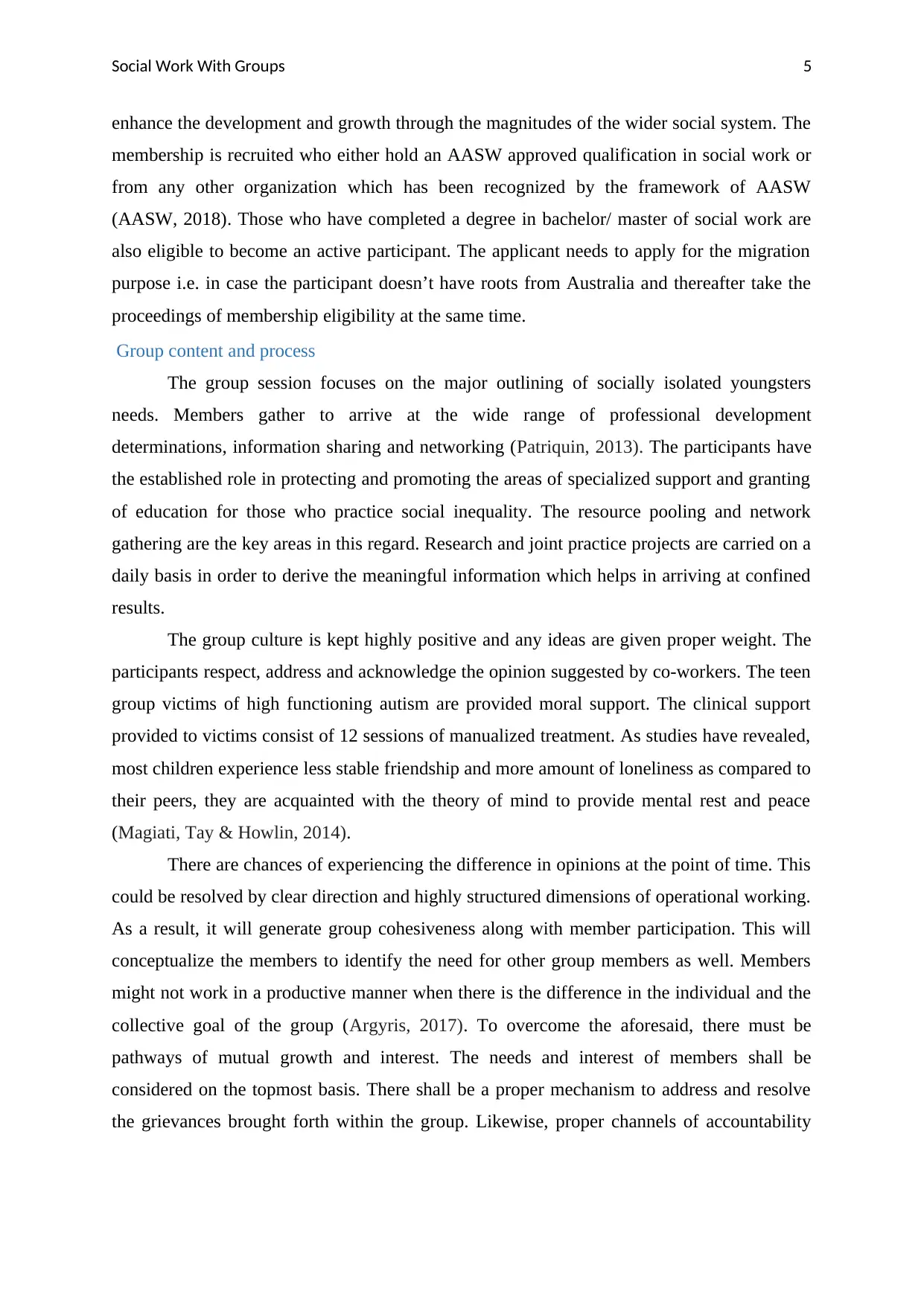
Social Work With Groups 5
enhance the development and growth through the magnitudes of the wider social system. The
membership is recruited who either hold an AASW approved qualification in social work or
from any other organization which has been recognized by the framework of AASW
(AASW, 2018). Those who have completed a degree in bachelor/ master of social work are
also eligible to become an active participant. The applicant needs to apply for the migration
purpose i.e. in case the participant doesn’t have roots from Australia and thereafter take the
proceedings of membership eligibility at the same time.
Group content and process
The group session focuses on the major outlining of socially isolated youngsters
needs. Members gather to arrive at the wide range of professional development
determinations, information sharing and networking (Patriquin, 2013). The participants have
the established role in protecting and promoting the areas of specialized support and granting
of education for those who practice social inequality. The resource pooling and network
gathering are the key areas in this regard. Research and joint practice projects are carried on a
daily basis in order to derive the meaningful information which helps in arriving at confined
results.
The group culture is kept highly positive and any ideas are given proper weight. The
participants respect, address and acknowledge the opinion suggested by co-workers. The teen
group victims of high functioning autism are provided moral support. The clinical support
provided to victims consist of 12 sessions of manualized treatment. As studies have revealed,
most children experience less stable friendship and more amount of loneliness as compared to
their peers, they are acquainted with the theory of mind to provide mental rest and peace
(Magiati, Tay & Howlin, 2014).
There are chances of experiencing the difference in opinions at the point of time. This
could be resolved by clear direction and highly structured dimensions of operational working.
As a result, it will generate group cohesiveness along with member participation. This will
conceptualize the members to identify the need for other group members as well. Members
might not work in a productive manner when there is the difference in the individual and the
collective goal of the group (Argyris, 2017). To overcome the aforesaid, there must be
pathways of mutual growth and interest. The needs and interest of members shall be
considered on the topmost basis. There shall be a proper mechanism to address and resolve
the grievances brought forth within the group. Likewise, proper channels of accountability
enhance the development and growth through the magnitudes of the wider social system. The
membership is recruited who either hold an AASW approved qualification in social work or
from any other organization which has been recognized by the framework of AASW
(AASW, 2018). Those who have completed a degree in bachelor/ master of social work are
also eligible to become an active participant. The applicant needs to apply for the migration
purpose i.e. in case the participant doesn’t have roots from Australia and thereafter take the
proceedings of membership eligibility at the same time.
Group content and process
The group session focuses on the major outlining of socially isolated youngsters
needs. Members gather to arrive at the wide range of professional development
determinations, information sharing and networking (Patriquin, 2013). The participants have
the established role in protecting and promoting the areas of specialized support and granting
of education for those who practice social inequality. The resource pooling and network
gathering are the key areas in this regard. Research and joint practice projects are carried on a
daily basis in order to derive the meaningful information which helps in arriving at confined
results.
The group culture is kept highly positive and any ideas are given proper weight. The
participants respect, address and acknowledge the opinion suggested by co-workers. The teen
group victims of high functioning autism are provided moral support. The clinical support
provided to victims consist of 12 sessions of manualized treatment. As studies have revealed,
most children experience less stable friendship and more amount of loneliness as compared to
their peers, they are acquainted with the theory of mind to provide mental rest and peace
(Magiati, Tay & Howlin, 2014).
There are chances of experiencing the difference in opinions at the point of time. This
could be resolved by clear direction and highly structured dimensions of operational working.
As a result, it will generate group cohesiveness along with member participation. This will
conceptualize the members to identify the need for other group members as well. Members
might not work in a productive manner when there is the difference in the individual and the
collective goal of the group (Argyris, 2017). To overcome the aforesaid, there must be
pathways of mutual growth and interest. The needs and interest of members shall be
considered on the topmost basis. There shall be a proper mechanism to address and resolve
the grievances brought forth within the group. Likewise, proper channels of accountability
⊘ This is a preview!⊘
Do you want full access?
Subscribe today to unlock all pages.

Trusted by 1+ million students worldwide
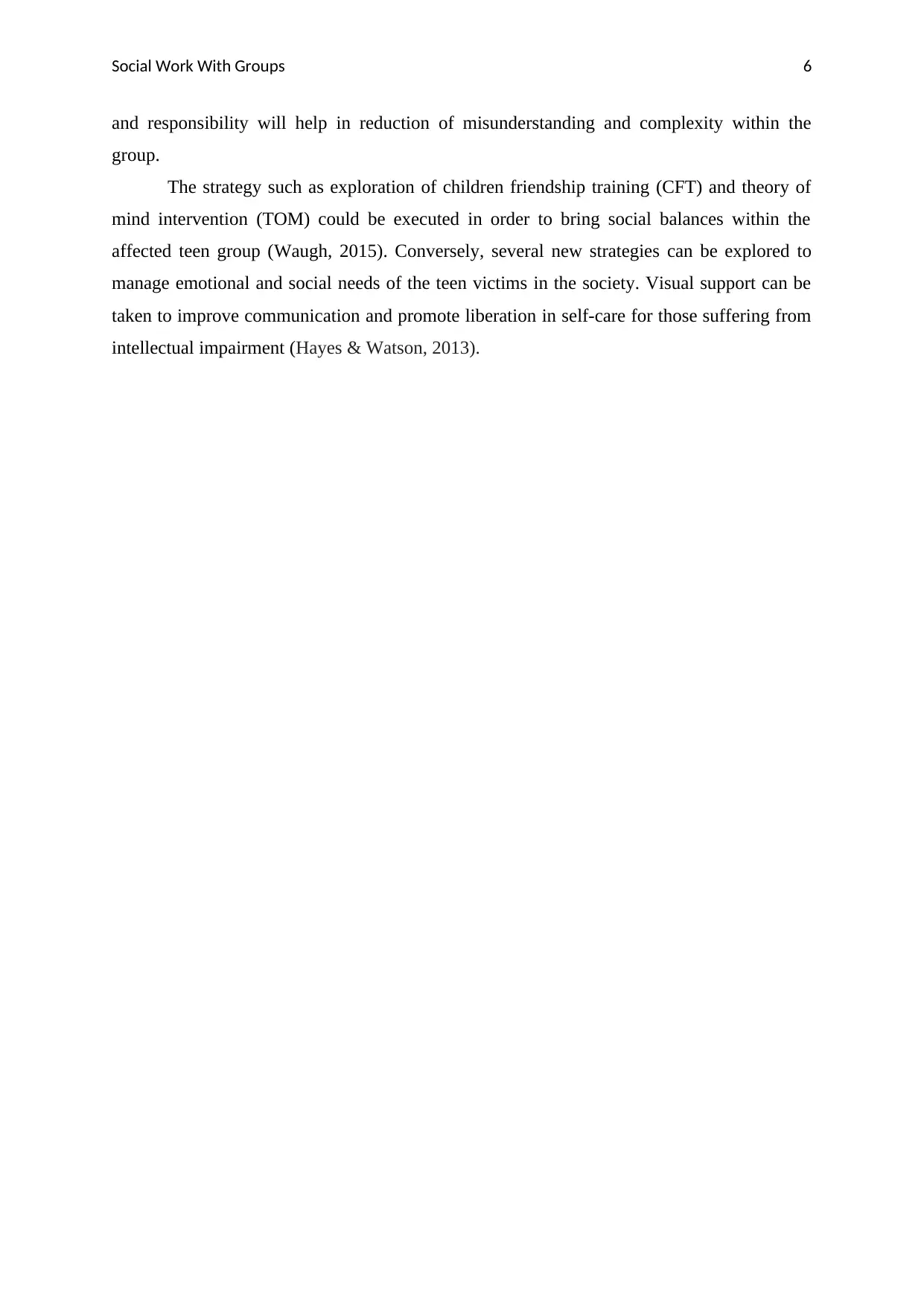
Social Work With Groups 6
and responsibility will help in reduction of misunderstanding and complexity within the
group.
The strategy such as exploration of children friendship training (CFT) and theory of
mind intervention (TOM) could be executed in order to bring social balances within the
affected teen group (Waugh, 2015). Conversely, several new strategies can be explored to
manage emotional and social needs of the teen victims in the society. Visual support can be
taken to improve communication and promote liberation in self-care for those suffering from
intellectual impairment (Hayes & Watson, 2013).
and responsibility will help in reduction of misunderstanding and complexity within the
group.
The strategy such as exploration of children friendship training (CFT) and theory of
mind intervention (TOM) could be executed in order to bring social balances within the
affected teen group (Waugh, 2015). Conversely, several new strategies can be explored to
manage emotional and social needs of the teen victims in the society. Visual support can be
taken to improve communication and promote liberation in self-care for those suffering from
intellectual impairment (Hayes & Watson, 2013).
Paraphrase This Document
Need a fresh take? Get an instant paraphrase of this document with our AI Paraphraser
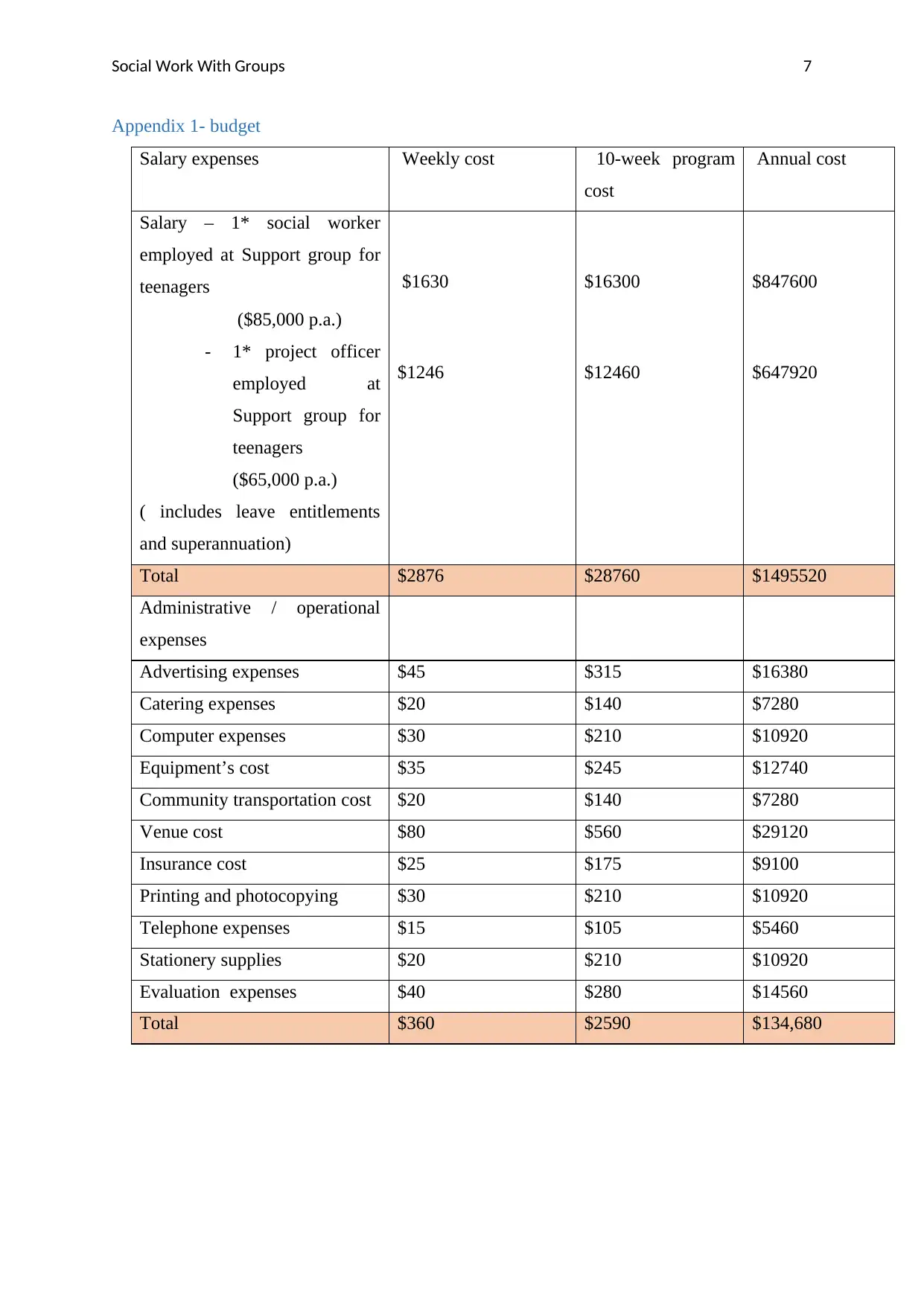
Social Work With Groups 7
Appendix 1- budget
Salary expenses Weekly cost 10-week program
cost
Annual cost
Salary – 1* social worker
employed at Support group for
teenagers
($85,000 p.a.)
- 1* project officer
employed at
Support group for
teenagers
($65,000 p.a.)
( includes leave entitlements
and superannuation)
$1630
$1246
$16300
$12460
$847600
$647920
Total $2876 $28760 $1495520
Administrative / operational
expenses
Advertising expenses $45 $315 $16380
Catering expenses $20 $140 $7280
Computer expenses $30 $210 $10920
Equipment’s cost $35 $245 $12740
Community transportation cost $20 $140 $7280
Venue cost $80 $560 $29120
Insurance cost $25 $175 $9100
Printing and photocopying $30 $210 $10920
Telephone expenses $15 $105 $5460
Stationery supplies $20 $210 $10920
Evaluation expenses $40 $280 $14560
Total $360 $2590 $134,680
Appendix 1- budget
Salary expenses Weekly cost 10-week program
cost
Annual cost
Salary – 1* social worker
employed at Support group for
teenagers
($85,000 p.a.)
- 1* project officer
employed at
Support group for
teenagers
($65,000 p.a.)
( includes leave entitlements
and superannuation)
$1630
$1246
$16300
$12460
$847600
$647920
Total $2876 $28760 $1495520
Administrative / operational
expenses
Advertising expenses $45 $315 $16380
Catering expenses $20 $140 $7280
Computer expenses $30 $210 $10920
Equipment’s cost $35 $245 $12740
Community transportation cost $20 $140 $7280
Venue cost $80 $560 $29120
Insurance cost $25 $175 $9100
Printing and photocopying $30 $210 $10920
Telephone expenses $15 $105 $5460
Stationery supplies $20 $210 $10920
Evaluation expenses $40 $280 $14560
Total $360 $2590 $134,680

Social Work With Groups 8
Evaluation and reporting
The effectiveness of the group will be evaluated by the formal process of the
questionnaire. The work procedure framed will be highly emphasized on the broad objectives
of the group. The individual assessment will be impartially focused upon. Questions would
be scaled in order to get the maximum amount of relative answers. The prior and post-event
feedback will be separately taken to evaluate the difference. It will also address the method of
delivery for the content within. The facilitator presentation, engagement, and skill will be
studied after successful completion. Recommendations and feedback from individuals will be
remarked for future work. Also, the willingness of an individual to participate in the future
program will be scrutinized.
Conclusion
The Support group for teenagers aims to address the social isolation and exclusion of
teenage group autism victims prevalent in the developed society. The impact and relevant
problems addressed by the adolescents’ in school, workplace are studied and measures are
suggested to overcome the circumstances. The group executes its effort to encourage and
bring the individual change and stand-in greater amount of community connectedness. The
rights for all are claimed on grounds of equality and commonness (Fox, 2013).
Since having a reciprocal and long-lasting friendship is the hallmark to achieve social
stability and justice especially in school and workplace (Scheeren, 2013). Members of the
group highlight the importance of concern in the society and suggest remediate measures to
overcome the cause. This is expected to bring improved social functioning and understanding
among the adolescents in the society. The qualified therapists provided by the Support group
for teenagers will make the difference in present scenario. Therefore, I will request the
supervisor to approve the forthcoming existence of Support group for teenagers as the group
promises to bring the change by further assessment and development required in this area.
Evaluation and reporting
The effectiveness of the group will be evaluated by the formal process of the
questionnaire. The work procedure framed will be highly emphasized on the broad objectives
of the group. The individual assessment will be impartially focused upon. Questions would
be scaled in order to get the maximum amount of relative answers. The prior and post-event
feedback will be separately taken to evaluate the difference. It will also address the method of
delivery for the content within. The facilitator presentation, engagement, and skill will be
studied after successful completion. Recommendations and feedback from individuals will be
remarked for future work. Also, the willingness of an individual to participate in the future
program will be scrutinized.
Conclusion
The Support group for teenagers aims to address the social isolation and exclusion of
teenage group autism victims prevalent in the developed society. The impact and relevant
problems addressed by the adolescents’ in school, workplace are studied and measures are
suggested to overcome the circumstances. The group executes its effort to encourage and
bring the individual change and stand-in greater amount of community connectedness. The
rights for all are claimed on grounds of equality and commonness (Fox, 2013).
Since having a reciprocal and long-lasting friendship is the hallmark to achieve social
stability and justice especially in school and workplace (Scheeren, 2013). Members of the
group highlight the importance of concern in the society and suggest remediate measures to
overcome the cause. This is expected to bring improved social functioning and understanding
among the adolescents in the society. The qualified therapists provided by the Support group
for teenagers will make the difference in present scenario. Therefore, I will request the
supervisor to approve the forthcoming existence of Support group for teenagers as the group
promises to bring the change by further assessment and development required in this area.
⊘ This is a preview!⊘
Do you want full access?
Subscribe today to unlock all pages.

Trusted by 1+ million students worldwide
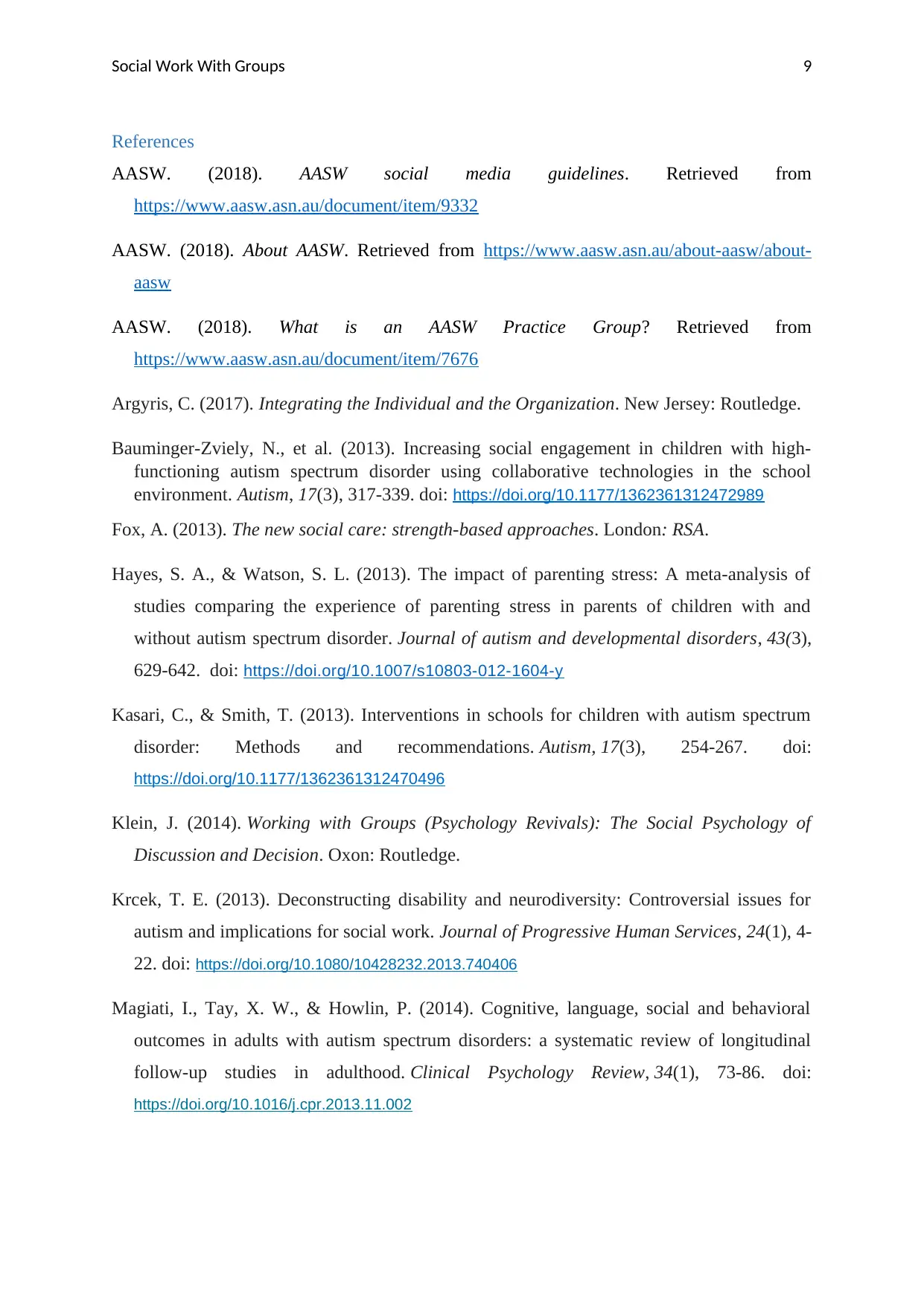
Social Work With Groups 9
References
AASW. (2018). AASW social media guidelines. Retrieved from
https://www.aasw.asn.au/document/item/9332
AASW. (2018). About AASW. Retrieved from https://www.aasw.asn.au/about-aasw/about-
aasw
AASW. (2018). What is an AASW Practice Group? Retrieved from
https://www.aasw.asn.au/document/item/7676
Argyris, C. (2017). Integrating the Individual and the Organization. New Jersey: Routledge.
Bauminger-Zviely, N., et al. (2013). Increasing social engagement in children with high-
functioning autism spectrum disorder using collaborative technologies in the school
environment. Autism, 17(3), 317-339. doi: https://doi.org/10.1177/1362361312472989
Fox, A. (2013). The new social care: strength-based approaches. London: RSA.
Hayes, S. A., & Watson, S. L. (2013). The impact of parenting stress: A meta-analysis of
studies comparing the experience of parenting stress in parents of children with and
without autism spectrum disorder. Journal of autism and developmental disorders, 43(3),
629-642. doi: https://doi.org/10.1007/s10803-012-1604-y
Kasari, C., & Smith, T. (2013). Interventions in schools for children with autism spectrum
disorder: Methods and recommendations. Autism, 17(3), 254-267. doi:
https://doi.org/10.1177/1362361312470496
Klein, J. (2014). Working with Groups (Psychology Revivals): The Social Psychology of
Discussion and Decision. Oxon: Routledge.
Krcek, T. E. (2013). Deconstructing disability and neurodiversity: Controversial issues for
autism and implications for social work. Journal of Progressive Human Services, 24(1), 4-
22. doi: https://doi.org/10.1080/10428232.2013.740406
Magiati, I., Tay, X. W., & Howlin, P. (2014). Cognitive, language, social and behavioral
outcomes in adults with autism spectrum disorders: a systematic review of longitudinal
follow-up studies in adulthood. Clinical Psychology Review, 34(1), 73-86. doi:
https://doi.org/10.1016/j.cpr.2013.11.002
References
AASW. (2018). AASW social media guidelines. Retrieved from
https://www.aasw.asn.au/document/item/9332
AASW. (2018). About AASW. Retrieved from https://www.aasw.asn.au/about-aasw/about-
aasw
AASW. (2018). What is an AASW Practice Group? Retrieved from
https://www.aasw.asn.au/document/item/7676
Argyris, C. (2017). Integrating the Individual and the Organization. New Jersey: Routledge.
Bauminger-Zviely, N., et al. (2013). Increasing social engagement in children with high-
functioning autism spectrum disorder using collaborative technologies in the school
environment. Autism, 17(3), 317-339. doi: https://doi.org/10.1177/1362361312472989
Fox, A. (2013). The new social care: strength-based approaches. London: RSA.
Hayes, S. A., & Watson, S. L. (2013). The impact of parenting stress: A meta-analysis of
studies comparing the experience of parenting stress in parents of children with and
without autism spectrum disorder. Journal of autism and developmental disorders, 43(3),
629-642. doi: https://doi.org/10.1007/s10803-012-1604-y
Kasari, C., & Smith, T. (2013). Interventions in schools for children with autism spectrum
disorder: Methods and recommendations. Autism, 17(3), 254-267. doi:
https://doi.org/10.1177/1362361312470496
Klein, J. (2014). Working with Groups (Psychology Revivals): The Social Psychology of
Discussion and Decision. Oxon: Routledge.
Krcek, T. E. (2013). Deconstructing disability and neurodiversity: Controversial issues for
autism and implications for social work. Journal of Progressive Human Services, 24(1), 4-
22. doi: https://doi.org/10.1080/10428232.2013.740406
Magiati, I., Tay, X. W., & Howlin, P. (2014). Cognitive, language, social and behavioral
outcomes in adults with autism spectrum disorders: a systematic review of longitudinal
follow-up studies in adulthood. Clinical Psychology Review, 34(1), 73-86. doi:
https://doi.org/10.1016/j.cpr.2013.11.002
Paraphrase This Document
Need a fresh take? Get an instant paraphrase of this document with our AI Paraphraser
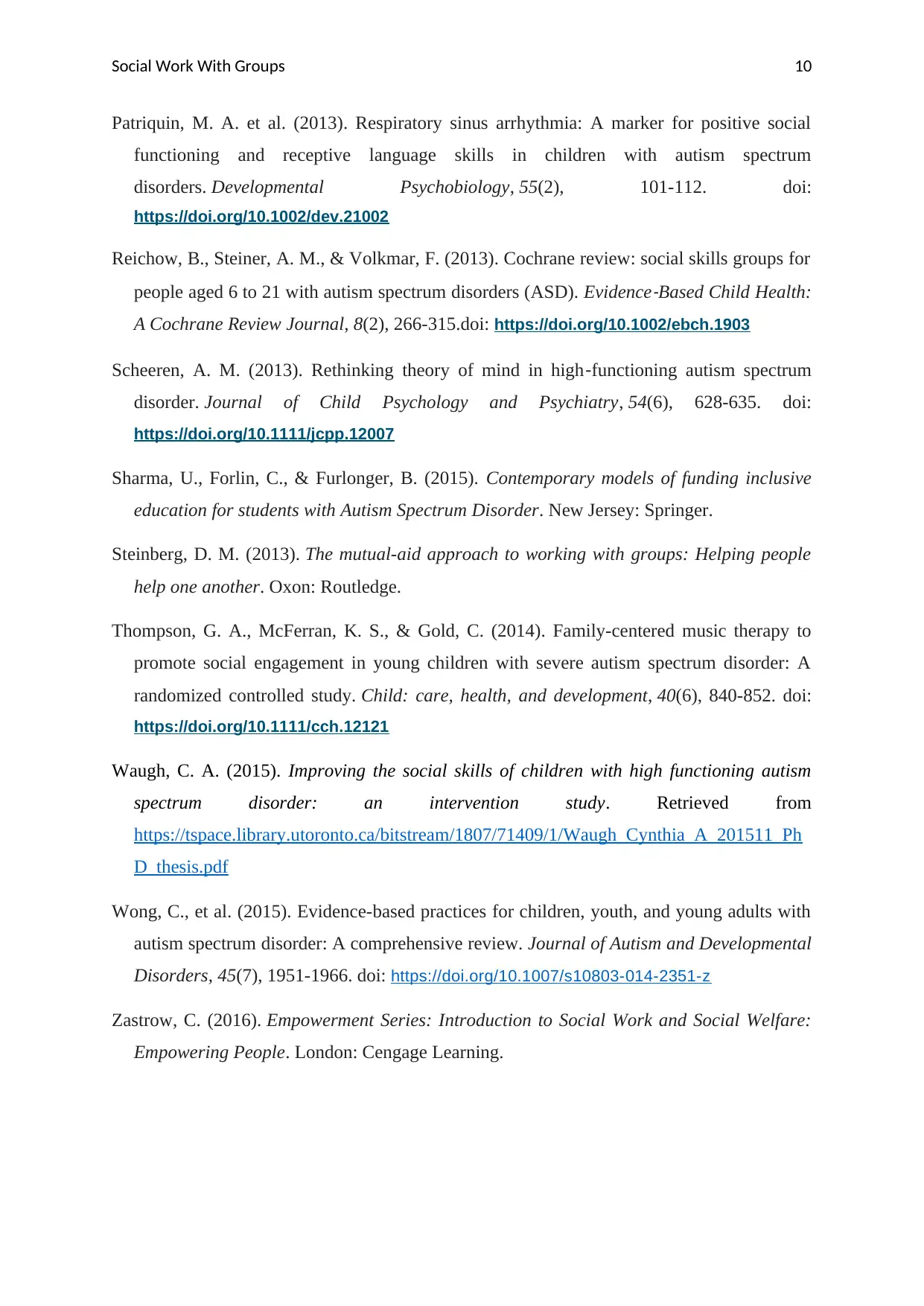
Social Work With Groups 10
Patriquin, M. A. et al. (2013). Respiratory sinus arrhythmia: A marker for positive social
functioning and receptive language skills in children with autism spectrum
disorders. Developmental Psychobiology, 55(2), 101-112. doi:
https://doi.org/10.1002/dev.21002
Reichow, B., Steiner, A. M., & Volkmar, F. (2013). Cochrane review: social skills groups for
people aged 6 to 21 with autism spectrum disorders (ASD). Evidence
‐Based Child Health:
A Cochrane Review Journal, 8(2), 266-315.doi: https://doi.org/10.1002/ebch.1903
Scheeren, A. M. (2013). Rethinking theory of mind in high‐functioning autism spectrum
disorder. Journal of Child Psychology and Psychiatry, 54(6), 628-635. doi:
https://doi.org/10.1111/jcpp.12007
Sharma, U., Forlin, C., & Furlonger, B. (2015). Contemporary models of funding inclusive
education for students with Autism Spectrum Disorder. New Jersey: Springer.
Steinberg, D. M. (2013). The mutual-aid approach to working with groups: Helping people
help one another. Oxon: Routledge.
Thompson, G. A., McFerran, K. S., & Gold, C. (2014). Family-centered music therapy to
promote social engagement in young children with severe autism spectrum disorder: A
randomized controlled study. Child: care, health, and development, 40(6), 840-852. doi:
https://doi.org/10.1111/cch.12121
Waugh, C. A. (2015). Improving the social skills of children with high functioning autism
spectrum disorder: an intervention study. Retrieved from
https://tspace.library.utoronto.ca/bitstream/1807/71409/1/Waugh_Cynthia_A_201511_Ph
D_thesis.pdf
Wong, C., et al. (2015). Evidence-based practices for children, youth, and young adults with
autism spectrum disorder: A comprehensive review. Journal of Autism and Developmental
Disorders, 45(7), 1951-1966. doi: https://doi.org/10.1007/s10803-014-2351-z
Zastrow, C. (2016). Empowerment Series: Introduction to Social Work and Social Welfare:
Empowering People. London: Cengage Learning.
Patriquin, M. A. et al. (2013). Respiratory sinus arrhythmia: A marker for positive social
functioning and receptive language skills in children with autism spectrum
disorders. Developmental Psychobiology, 55(2), 101-112. doi:
https://doi.org/10.1002/dev.21002
Reichow, B., Steiner, A. M., & Volkmar, F. (2013). Cochrane review: social skills groups for
people aged 6 to 21 with autism spectrum disorders (ASD). Evidence
‐Based Child Health:
A Cochrane Review Journal, 8(2), 266-315.doi: https://doi.org/10.1002/ebch.1903
Scheeren, A. M. (2013). Rethinking theory of mind in high‐functioning autism spectrum
disorder. Journal of Child Psychology and Psychiatry, 54(6), 628-635. doi:
https://doi.org/10.1111/jcpp.12007
Sharma, U., Forlin, C., & Furlonger, B. (2015). Contemporary models of funding inclusive
education for students with Autism Spectrum Disorder. New Jersey: Springer.
Steinberg, D. M. (2013). The mutual-aid approach to working with groups: Helping people
help one another. Oxon: Routledge.
Thompson, G. A., McFerran, K. S., & Gold, C. (2014). Family-centered music therapy to
promote social engagement in young children with severe autism spectrum disorder: A
randomized controlled study. Child: care, health, and development, 40(6), 840-852. doi:
https://doi.org/10.1111/cch.12121
Waugh, C. A. (2015). Improving the social skills of children with high functioning autism
spectrum disorder: an intervention study. Retrieved from
https://tspace.library.utoronto.ca/bitstream/1807/71409/1/Waugh_Cynthia_A_201511_Ph
D_thesis.pdf
Wong, C., et al. (2015). Evidence-based practices for children, youth, and young adults with
autism spectrum disorder: A comprehensive review. Journal of Autism and Developmental
Disorders, 45(7), 1951-1966. doi: https://doi.org/10.1007/s10803-014-2351-z
Zastrow, C. (2016). Empowerment Series: Introduction to Social Work and Social Welfare:
Empowering People. London: Cengage Learning.
1 out of 11
Related Documents
Your All-in-One AI-Powered Toolkit for Academic Success.
+13062052269
info@desklib.com
Available 24*7 on WhatsApp / Email
![[object Object]](/_next/static/media/star-bottom.7253800d.svg)
Unlock your academic potential
Copyright © 2020–2025 A2Z Services. All Rights Reserved. Developed and managed by ZUCOL.





